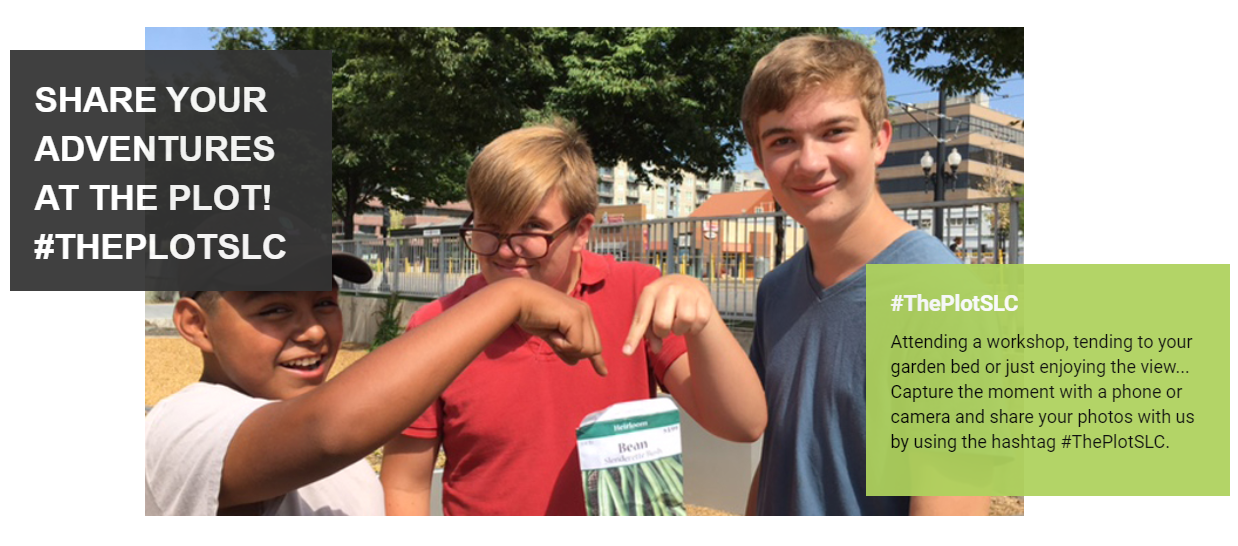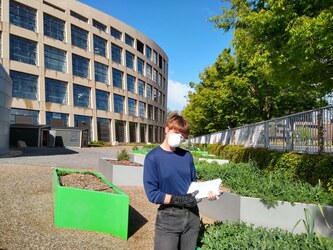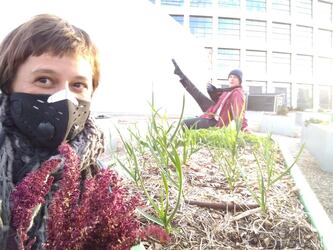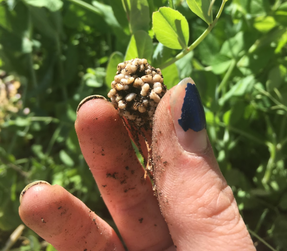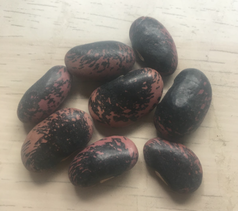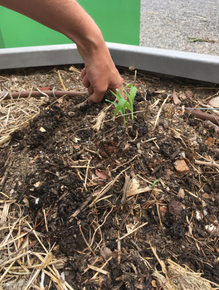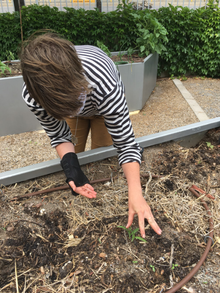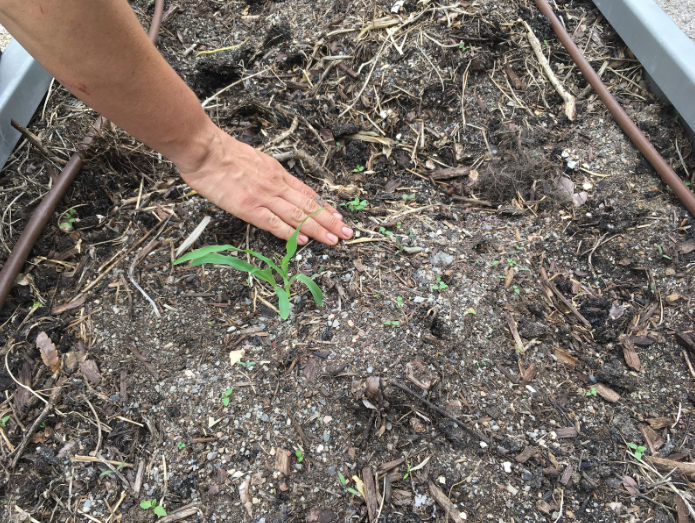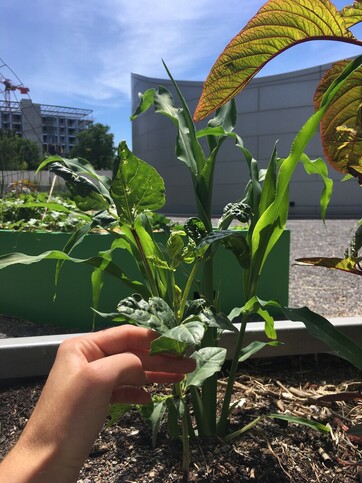|
by Emmett and Rikki, The Plot Garden Coordinators The PlotDid you know that the Main Library has a community garden? It does! It's called The Plot. Get it? Eh? Well, in addition to having a community garden, we also have two awesome Garden Coordinators: Emmett Wilson and Rikki Longino. Typically they help library users like you set up garden spaces in The Plot, host planting, harvesting, and even yoga workshops, and lovingly tend to the library gargen. This year things are a bit different. With the pandemic going on, we could not invite our community to create their own garden beds this year, but Emmett and Rikki still planted the garden full, and even added an edible garden pathway along the sidewalk on 400 south! Food grown in this year's garden will be donated to local shelters and community organizations. We hope you take a chance to visit the garden the next time you are downtown. Today's guest post by Emmett and Rikki is all about planting beans. Enjoy! - Steph C. Fee, Fi, Fo, Fum, I hear the crunch of some beans, yum!What kind of beans are we talking about here? Coffee beans? Vanilla beans? We’re talking about green beans, lima beans, Purple Queen beans, and more! These are members of the Fabaceae or Leguminosea family, otherwise known as legumes, and commonly known as the Pea and Bean family. They fix nitrogen in the soil by developing rhizomes or ‘nitrogenous nodes’ on their roots that attract nitrogen from the soil (see photo). Above the ground, these plants grow pods containing the beans we know and love. Their nitrogen-fixing abilities make them great plants to grow in soil that might be depleted of this vital element from growing plants like tomatoes or cucumbers, both ‘heavy feeders’. Legumes like beans are the ‘universal donors’ of the plant community. There are two main categories of beans in the legume family: bush and pole, and many varieties within those categories. The categories describe themselves pretty well. Bush bean plants grow in a stout way, like a bush, and pole beans grow very tall, requiring a pole or some sort of trellising to support their growth. We planted both categories of beans at The Plot community garden! One of the Three SistersWho are the other two sisters besides pole beans? Corn and squash! This brilliant trio of plant sisters has been at the center of Native American agriculture and cuisine for centuries. How they collaborate: ‘Corn provides tall stalks for the beans to climb so that they are not out-competed by sprawling squash vines. Beans provide nitrogen to fertilize the soil while also stabilizing the tall corn during heavy winds. Beans are nitrogen-fixers meaning they host rhizobia on their roots that can take nitrogen, a much needed plant nutrient, from the air and convert it into forms that can be absorbed by plant roots. The large leaves of squash plants shade the ground which helps retain soil moisture and prevent weeds. These three crops are also at the center of culinary traditions and complement one another as well. A diet of corn, beans, and squash is complete and balanced. Corn provides carbohydrates and the dried beans are rich in protein and have amino acids absent from corn. Squash provides different vitamins and minerals than corn and beans. These three crops are also important because they can all be dried and used for food year round. These traits are less important today, but were important in the past which lead to their significance as the major cultivated foods. The tradition of calling these crops the "Three Sisters" originated with the Haudenosaunee, pronounced Ho-deh-no-shaw-nee. Also known as the Iroquois, Haudenosaunee occupy the regions around the Great Lake in the Northeastern United States and Canada. All three types of seeds are planted together in the same mound in the Haudenasaunee planting method. The elevated mound assists with drainage and avoids water logging of the plant roots which is important in this region that receives abundant rainfall in the summer.’ Source: Melissa Kruse-Peeples, Education Coordinator of Native Seeds SEARCH. We have planted three types of beans: 1.Scarlet Runner Beans are very similar to pole beans in the heart shape of their leaves and the fact that they grow tall enough to require a pole or some sort of trellising to support their growth. They are usually grown for their pretty red flowers, but their pods contain beans that can be eaten fresh or dried and boiled later. 2. Red Noodle Beans were planted as a part of the three sisters demonstration around the corn sprouts. It is best to plant the corn first, then the beans and squash, allowing the corn a week or two to get established before physically supporting the beans that will grow faster than the corn. Emmett made 2-3 inch deep holes to plant 2-3 beans around each corn sprout. Rikki covered each hole with a little soil. The beans were planted about 4 inches away from the corn sprout to give all the roots room to grow. 3. Trio Bush Beans were soaked overnight before planting. This is not a necessary step for growing beans, but will speed up the process of imbibition: the uptake of water by seeds. This trio includes Blue Lake 274, Cherokee Wax, and Purple Queen Bean varieties. Soaking beans is easy. This is also a great thing to do if you are wanting to cook them. The water helps soften the beans and hydrates them for growth, or prepares them for being cooked! Do you need some free seeds to start your garden? We can mail some to you! Check out our seed catalog today on The Plot webpage. Happy planting! The City Library encourages a respectful and focused dialogue on blog posts. Comments must be reviewed by a blog administrator. User comments represent the views and interpretations of the patron, not necessarily those of The City Library.
0 Comments
Your comment will be posted after it is approved.
Leave a Reply. |
AuthorsBlog posts are written by our Teen Librarians and, in some cases, teens like you. Visit your About page to learn more about our Teen Librarians. Archives
August 2023
Categories
All
|
